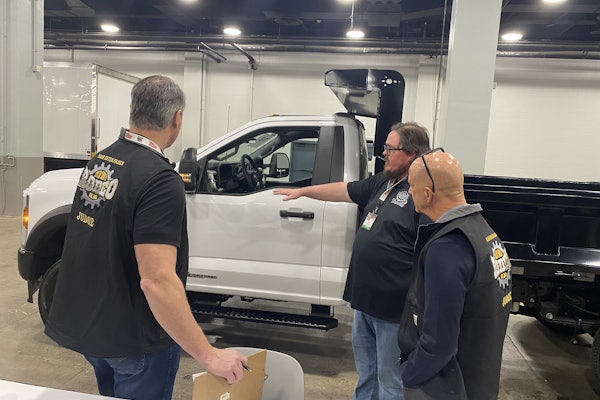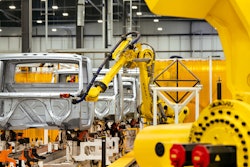From the hair raising to the head shaking, this year’s annual collection of cautionary tales shows that when it comes to truck repairs and service, what can go wrong often will. But usually only when a technician becomes inattentive to his work or tries to cut corners.
Other times, it’s just a matter of best intentions thwarted by an overlooked factor that becomes quite obvious in retrospect. For instance, simple physics in the case of mismatched wheels or unexpectedly learning Chemistry 101 when applying a heat source to a combustible gas.
Most every technician knows the right way to do something, and most every technician, at some point in their career, tries to improve on the accepted best practice. Sometimes it results in a breakthrough, sometimes it results in something just breaking. Shop ingenuity is often the result of trial and error.
No one was hurt in any of these stories. But the results could have been far more dire in a few cases. So while this collection of tales is meant as much to amuse as inform, never snicker at safety.
“The lesson is, you simply can never be too careful,” says Jim Boyd, manager of fleet technical services with Southeastern Freight Lines. “And I don’t care how much money or effort you put toward prevention and safety. I promise you it is money in the bank. Nobody does too much when it comes to safety.”
Also, many of these stories, like all good lore, have been passed around from technician to technician, from shop to shop. They were not necessarily witnessed firsthand by the storytellers, nor were their companies – past and present – necessarily involved.
If you have a story you would like to share for possible inclusion in next year’s Halloween-themed cover story, please submit it to [email protected].
The Transfer Station Terror
Part of the technician’s job is sometimes reaching into, under and around things shrouded in darkness or blocked from view. Whether it’s checking the tension of something or feeling for moisture to detect a possible a leak, a technician’s hands often venture into the unknown. What lurks there is usually nothing, but you can’t always be sure.
Damon Russell, a master ASE technician who owns New Jersey-based Fleet Guardian LLC, has worked on countless trucks and poked and prodded his way through many a repair and service job. But there was one particular service call that he wasn’t putting his hands anywhere near.
He and a colleague were conducting maintenance on refuse trucks and trailers at a municipal transfer station when they came upon a trailer that stood out from the rest.
“We were responsible for grease and adjusting brakes and checking air and tires and so forth and so on,” Russell says. “So we were just going right on down the line, and we get to one trailer that was covered by what literally looks like a spider web from the landing gear crank all the way down to the trailer wheels.
“Neither one of us wanted to go under this thing because we had no idea what it was. We’re thinking there’s got to be a four-foot diameter spider underneath this thing.”
They did what any sensible team of technicians would do.
“We just wrote that one off,” he says. “That trailer was not in the yard as far as we were concerned. We didn’t service that one; we weren’t going under it. You couldn’t even touch the landing gear handle, it was just covered. We looked at each other and it was ‘uh-uh, I don’t think so.'”
But whether it was a sense of duty or curiosity, Russell says he eventually did go in for a closer look. The cause of suspicion and apprehension was not the silky strands spun by a giant arachnid, draping the trailer to catch its next prey. It was corn syrup. Russell explains that the trailer had a live-action floor so it was not waterproof. A discarded can or jug spilled its syrupy contents, which dripped through the bottom of the trailer.
“So whatever this was, it was dripping, and this syrupy substance was getting caught by the wind and making a strand. Each gust of wind would add another strand,” says Russell. “So after about 10 hours of this dripping, it made a web that was literally 45 feet long and 4 feet high. It completely covered the bottom of the trailer like a curtain.
“I honestly thought it was made by something animal, I really did. I thought there was some huge bug or something that did this. But as it turned out, it was a can of some clear syrup or corn starch or something, but it made an awesome web.”
It Came from the Crankcase
Sometimes, not oil’s well that ends well. Particularly if it’s oil gushing forth in the shop as though it was being pumped from a well.
Jim Boyd, manager of fleet technical services with Southeastern Freight Lines, recalls the story of a technician at a local dealership who struck black gold and wished he had not.
The technician was working to fix exposed wiring that fed the injectors under the valve cover. He had the valve cover off the engine and went about cleaning the connections and making the wiring like new again.
“Even though he intended to do the right thing, he went and got a can of ether – which is diesel starting fluid and very combustible,” says Boyd. “He cleaned some of the connectors with it and wiped them off and then stripped and crimped his wires, making nice, new electrical connections.”
Nearly finished with his job, the technician next went to seal the shrink tube he had used to cover the wires, a process which requires heat and usually results in a solid, sealed and secure electrical connection.
“So this gentleman put some shrink tubing over the wire, soldered and crimped his connections, and cleaned everything up with ether,” says Boyd. “When he went to use a very small torch to heat the heat-shrinkable tubing, the ether had settled in the lower portions of the engine because it is much heavier than air.
“When he lit that torch, it blew the oil pan off the engine and blew 40 quarts of oil all over shop.”
Oil virtually covered the shop, reaching the ceiling and dripping everywhere.
“This gentleman was not hurt, although he was dazed and appeared to be in the no zone for about 20 or 30 minutes,” says Boyd. “It was a tremendous explosion.”
Mismatched Mayhem
Getting to the root cause of mysterious sounds often requires a gifted technician with keen senses. But, in some cases, it simply requires a tape measure.
Tom MacKay, a district manager with ArvinMeritor, was looking into a customer complaint of a strange popping sound coming from the truck’s forward carrier of a Meritor RT40145 tandem. It occurred when the interaxle differential was engaged and the fleet was at a loss to determine the source of the mysterious sound.
They removed the forward carrier to inspect for damage, but did not find any problems. That’s when they went for outside help and MacKay was brought in.
“I agreed with them that the forward carrier was fine,” says MacKay. “While inspecting the truck, I noticed that the tires on the rear axle were new and the tires on the forward axle were worn. Measuring the diameter of both sets showed a diameter difference of 1 inch between the axles.”
MacKay says they reinstalled the forward carrier and replaced the tires on the forward axle.
“The popping noise was the interaxle differential trying to equalize the difference in tire revolutions between the axles,” he says. “Lesson learned – match your drive axle tires!”
They did, and the popping sound was never heard again.
Bedeviling Brakes
Skipping inspections and cutting corners on maintenance – whether to try and save time, money or both – can have disastrous effects. And for the technician or operator who chooses to do so, when the error of his ways is discovered, he can find himself in the hot seat.
Sometimes quite literally.
John Hawker, a service engineer for Bendix Spicer Foundation Brake, shares a story of a truck that lost a seal on its spring brake. As air leaked out of the system, the brakes were applied.
“The driver was unaware that air was starting to bleed off and the brakes were being applied, and only realized it when smoke began to come from his tires,” Hawker says. “Before he could get off the interstate, the wheels actually caught fire.
“Fortunately, the driver was uninjured, but a simple check for air leaks could have prevented this dangerous situation.”
Another instance of a skipped, or at least misread, inspection check resulted in a minor crash that could have been worse.
Frank Janeczko, a district manager with ArvinMeritor, was asked to investigate a complaint of poor brake performance that was thought to be the cause of a minor accident.
Janeczko recalls the owner of the vehicle was insistent a brake balance test be run on the truck, while he first wanted to check the brake stroke, per Commercial Vehicle Safety Alliance (CVSA) procedures.
“The owner objected, saying his mechanic had adjusted the brakes,” says Janeczko. “When I went to check the first brake chamber there was a significant air leak caused by a cracked brake hose. The discouraging thing is that this truck had been at a dealership and they found no problem. Had brake stroke been checked per CVSA procedure, the problem would have been found, avoiding a minor accident which could have been a major accident. Things like this are why brakes still account for 52.6 percent of out of service vehicle defects.”
Counterfeit parts can contribute to spooky scenarios as well, sometimes causing cold, hard cash to simply disappear.
Andy Cifranic, brand manager with Bendix Commercial Vehicle Systems, tells the story of a fleet that was having trouble with an air dryer on one of its vehicles. The fleet decided to replace the part with a remanufactured Bendix-branded air dryer that was remanufactured by a company other than Bendix.
“Unbeknownst to the fleet, the remanufactured air dryer contained a counterfeit cartridge, one claiming to be genuine Bendix but, in reality, it was nothing more than a cheap imitation,” Cifranic says. “Only three months after the dryer was installed, leaks in the air brake system forced the fleet to take the vehicle in for service.”
According to Cifranic, one of the fleet’s service technicians fixed several air leaks downstream from the air dryer. In doing so, he noticed that the leaks were being caused by loose desiccant that was clogging up valves.
“But the damage didn’t stop there,” says Cifranic. “The automatic transmission, which uses the same pressurized air as the air brake system, also was damaged by the loose desiccant.”
During the three months the deceptive air dryer was installed, Cifranic says, a significant amount of desiccant escaped, damaging several components in the brake and transmission systems.
“Several thousand dollars and a new air dryer later, the vehicle was repaired and back on the road,” says Cifranic. “However, a counterfeit cartridge hidden inside a competitive remanufactured air dryer ended up costing the fleet more than 60 times the original cost of the air dryer.”
Plight of the Persistent Parasites
They are everywhere. Feeding their insatiable hunger with whatever they can scavenge. They are in your bed. They are on your skin. They lurk everywhere – even in tanks of diesel fuel!
Invisible to the unaided eye, microbes flourish in the harshest conditions on the planet. They are found in environments where scientists once thought life could not be sustained – super-hot volcanic vents deep on the ocean floor, frozen soil and highly acidic deposits. Not surprisingly, then, they can also be found in diesel fuel tanks. And once they are there, they can be difficult to evict.
Just ask former director of maintenance for Signal Delivery, Bob Deal.
“If you go get a glass full of fuel, and you put it on a windowsill for about a week, the water and the fuel will separate,” says Deal. “And the little bugs will grow between that interface, actual microbes. They’ll get so bad you can’t pour water through a filter.”
According to Deal, who is now retired, the fleet was experiencing problems with bad fuel. Filters were getting clogged and trucks wouldn’t run. Deal suspected microbes in the company’s diesel fuel reservoir tanks and went about ridding themselves of the problem with a biocide additive. The additive, formulated to kill microbes, was put into the bulk reservoirs and into the truck fuel tanks.
Problem solved, or so he thought. A while later, the trucks began experiencing the same problems.
“The next week, we still had bad fuel,” Deal says. “You know why? I forgot to clean the risers that come out of the tank. I forgot to clean those pipes, because I never thought about it. So we had microbes in the pipes, and every time we fueled up, we had the same microbes getting into the trucks all over again.”
Risers, or breather tubes, extend from bulk fuel tanks and allow air to escape as the tanks are filled. In this case, they also provided a safe haven for the infestation. “When you fill the storage tank, the air has somewhere to go, so it goes up that pipe,” says Deal. “Well, the microbes go up there too.”
Deal discovered his error and went about applying the biocide to the riser tubes. The menace was finally eradicated.







